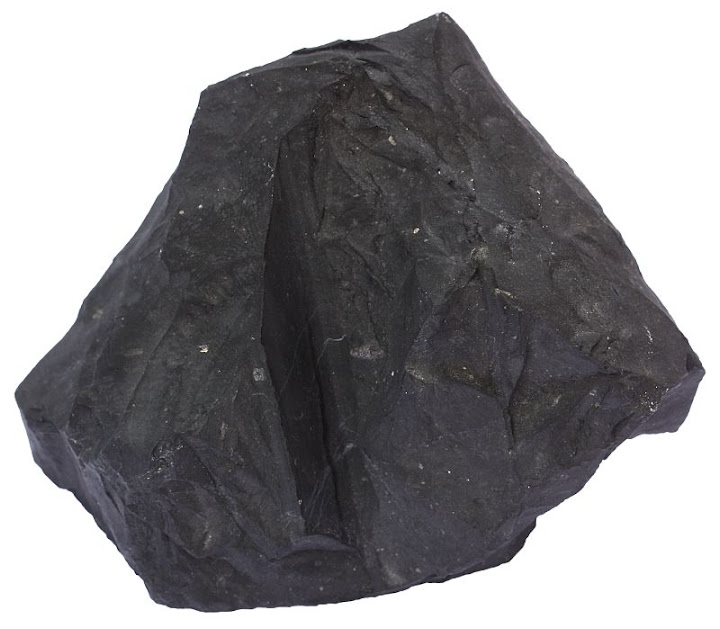Shungite is a carbon-rich metamorphic rock. It is largely composed of carbon, up to 98% in some cases, but interesting fact is that this carbon is not mineral graphite. Shungite is believed to be a metamorphosed oil shale, although there are other possible explanations. The most famous locality where large deposit is found is in Karelia, near Shun’ga village (hence the name of the rock type).
Karelian shungite is very old (2.0 Ga) which makes it one of the earliest known occurrences of oil shale, albeit metamorphosed. It has been a favorite example of an abiogenic petroleum source rock but there is no doubt anymore that shungite has a biogenic origin, most likely algal or bacterial1.
The chemical composition of shungite is similar to anthracite (metamorphosed coal) but their genesis is different. Oil shale is a former accumulation of marine microorganisms (bacteria, algae), but coal formed from organic matter deposited in terrestrial environments.
The rock is black in color, but it is not greasy and dirty as one would expect a carbon-rich rock to be. This is because it does not contain graphite. Carbon is almost structureless (amorphous or nanocrystalline) and it forms coal-like seams. It is believed to be one of the oldest known occurrences of petroleum generation. There is no crude oil in Karelia at the moment, but shungite is believed to have been both the kerogen-rich source rock of crude oil and also petroleum itself that have migrated (both vertically and horizontally) away from the source rocks.

Shungite from Karelia. Width of sample 7 cm.
Shungite was for some time known to contain fullerenes (carbon nanotubes and spheres) but studies conducted later have failed to confirm this. It has gathered fame as a natural medicine for a long time. It is true that shungite has anti-bacterial properties but it is highly unlikely that it has all the powers attributed to it (kills and devours anything that harms people and concentrates and restores all that is good). The fact that this rock is old does not give it any magical power. After all, two billion years is nothing very special in geology. Many gneissose rocks are much older than that, unfortunately they tend to be largely neglected and only have a value as a railroad ballast.
References
1. Melezhik, V. A., Fallick, A. E., Filippov, M. M., & Larsen, O. (1999). Karelian shungite—an indication of 2.0-Ga-old metamorphosed oil-shale and generation of petroleum: geology, lithology and geochemistry Earth-Science Reviews, 47 (1–2), 1-40 DOI: 10.1016/S0012-8252(99)00027-6
Hi,
Came across your website while researching Shungite. What studies indicated that Shungite does not contain fullerenes? This study
found fullerenes in specific samples: http://geology.geoscienceworld.org/content/31/1/e32.full?ck=nck
Thanks,
Tim
Hi Tim,
I believe it was the same paper. Sentence from the abstract: “The authors confirm the presence of fullerenes in the Onaping Formation, Black Tuff from Sudbury, Ontario, but do not find fullerenes in carbon-rich shungite rocks from the Lake Onega region of Karelia, Russia.”
I do not have access to the full article, though.